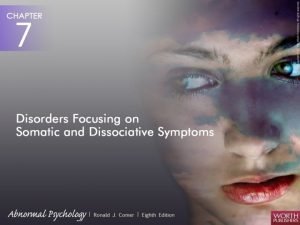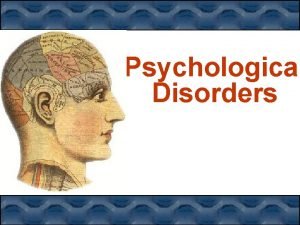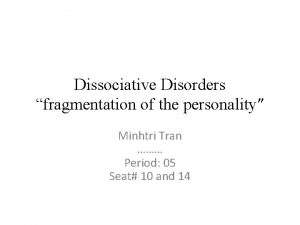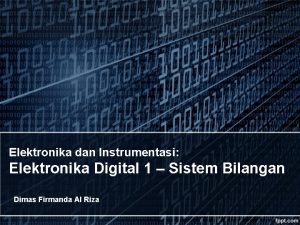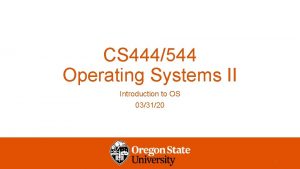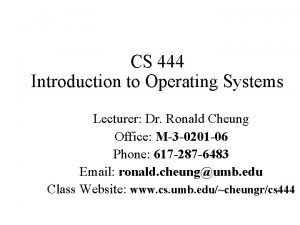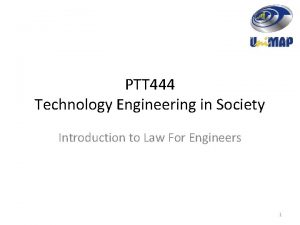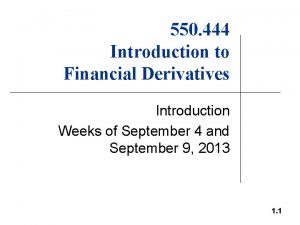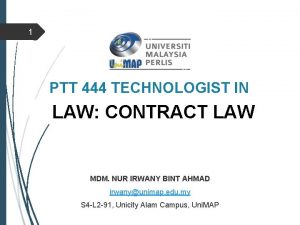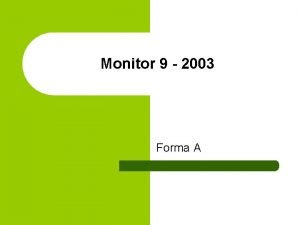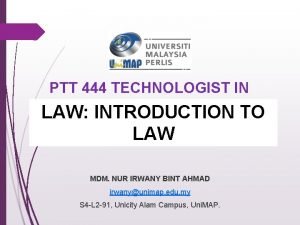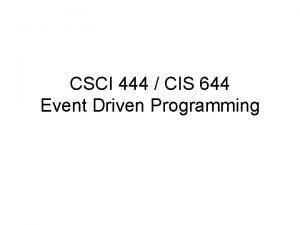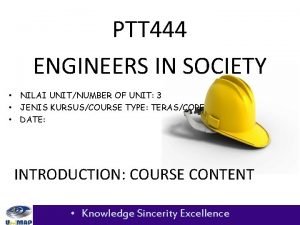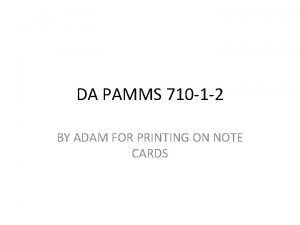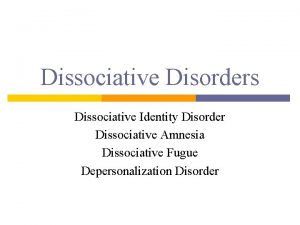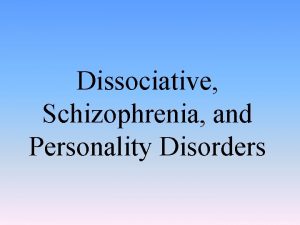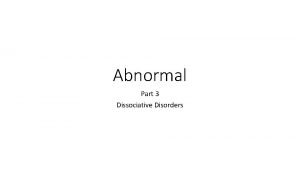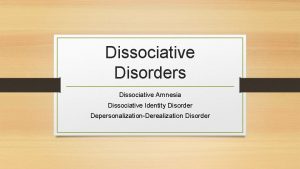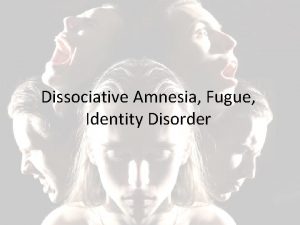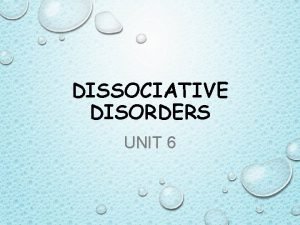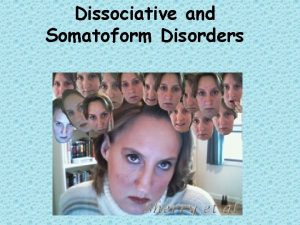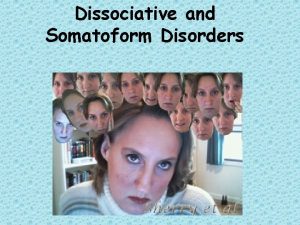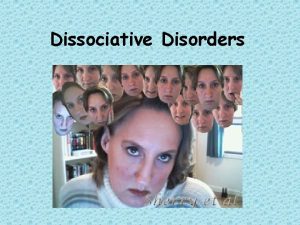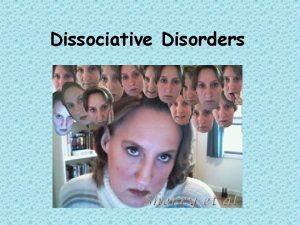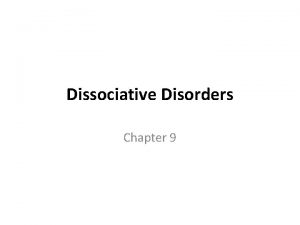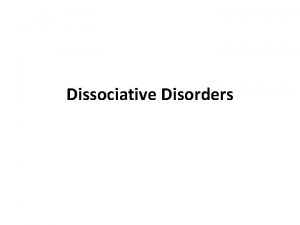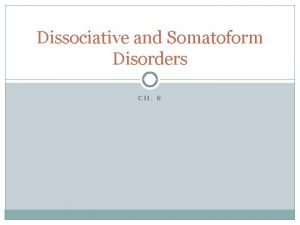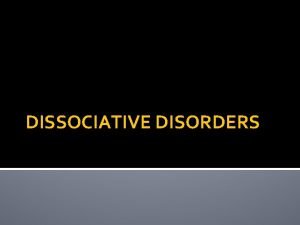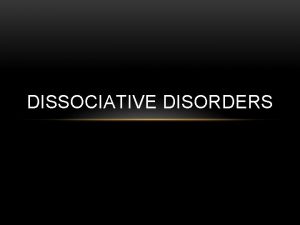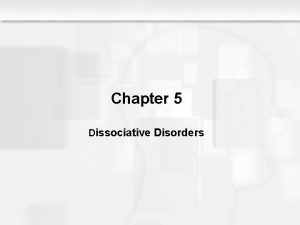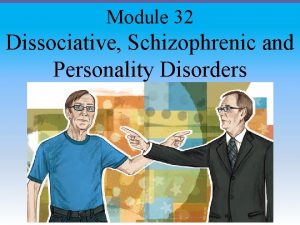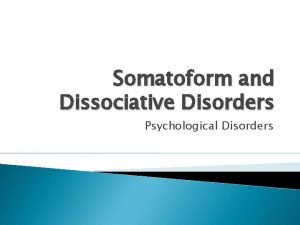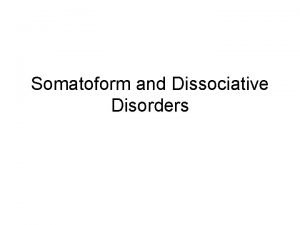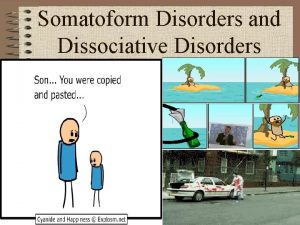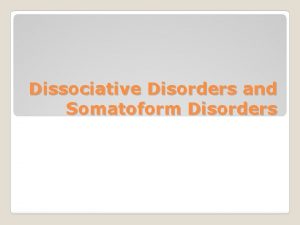Dissociative Disorders NUR 444 FALL 2015 READING Read






























- Slides: 30

Dissociative Disorders NUR 444 FALL 2015

READING � Read Chapter 29 � Townsend, M. (2015). Psychiatric mental health nursing: Concepts of care in evidence-based practice (8 th ed. ).

OBJECTIVES 1. Differentiate the four types of Dissociative Disorders � � 2. 3. 4. Dissociative Identity Disorder Dissociative Amnesia Dissociative Fugue Depersonalization Disorder Identify predisposing factors in the development of Dissociative Disorders Identify nursing diagnoses frequently used in the management of clients experiencing Dissociative Disorders. Identify nursing interventions and treatment approaches for clients with Dissociative Disorders

DISSOCIATIVE DISORDERS �A sudden disruption in the patient's � consciousness � identity � memory Occurs when anxiety becomes overwhelming and the persons personality become disorganized.

DISSOCIATIVE DISORDERS � Defense Mechanisms 1. Dissociation 2. Repression “The trance states”

DISSOCIATIVE DISORDERS CAUSES � Traumatic Experience � Psychoactive Drugs � Hallucinogens or cannabis � Severe childhood abuse (physical, sexual, emotional) � Child learns to detach or dissociate from intolerable situations � Continues to dissociate when experiencing stressful events as an adult

DISSOCIATIVE DISORDERS � 1. Dissociative Amnesia � 2. Dissociative Fugue � 3. Dissociative Identity Disorder (DID) � Multiple � 4. personalities Depersonalization Disorder

DISSOCIATIVE AMNESIA � Patient cannot remember important personal information � Cannot be accounted for by ordinary forgetfulness. � Suddenly unable to recall memories � Most common during wars and natural disasters � Usually terminates abruptly � Not due to substance use, neurological or general medical condition

DISSOCIATIVE AMNESIA � Is very rare � More common in women � More common in young than in older adults � Difficult to diagnose in children � Usually appear alert � At onset may have brief period of disorganization or clouding of consciousness � Usually found wandering

DISSOCIATIVE AMNESIA 1. Localized Amnesia � Inability to recall incidents associated with the traumatic event for a specific time period following the event � Usually a few hours to a few days � EX: car accident- not remembering the few days after the accident

DISSOCIATIVE AMNESIA 2. Selective Amnesia � Inability to recall only certain incidents associated with the traumatic event � EX: may not remember events leading to the impact of the accident but may remember being taken away in ambulance

DISSOCIATIVE AMNESIA 3. Generalized Amnesia- Rare phenomenon of not being able to recall anything during entire lifetime, including personal identity

DISSOCIATIVE AMNESIA 4. Continuous Amnesia � Inability to recall events occurring after a specific time up to and including the present. � EX: individual cannot recall events associated with accident and anything that has occurred since. Cannot form new memories even though alert and aware

DISSOCIATIVE AMNESIA 5. Systematized Amnesia � Cannot remember events that relate to a specific category of information or to one particular person or event � EX: one’s spouse

DISSOCIATIVE FUGUE Unexplained Travel � Sudden, unexpected travel away from home or customary workplace � Unable to recall personal identity � Assumption of a new identity is common � Response to psychological stressors (family and martial are more common) � War/natural disasters �

DISSOCIATIVE FUGUE � Predisposing � History factors include of substance abuse � Depression and suicidal ideation � Certain personality disorders � Organic brain disorders

DISSOCIATIVE AMNESIA � Outcomes � Can recall events associated with traumatic or stressful situation � Can recall events of past life � Can demonstrate more adaptive coping strategies to avert amnestic behaviors in the face of severe anxiety � Verbalizes control over certain life situations � Verbalizes acceptance of certain life situations over which he or she has no control � Sets realistic goals and expresses a sense of control over outcomes for the future � Returns to level of functioning-social/occupational

DISSOCIATIVE IDENTITY DISORDER (DID) � 2 or more distinct personalities or identities (alters) in an individual person � Formerly known as multiple personality disorder

DID � Personalities have different influences and power over one another � Host personality: Primary identity that holds the persons name � May represent different ages, genders � “switching” occurs by dissociating from one alter to another � Co-consciousness

DID � Unable to give full account of childhood because of dissociation � Marked variation in appearance from time to time � Blinking, eye rolls, headaches, covering or hiding the face, and twitches may occur when “switching” � Marked variation in speech � May appear anxious or depressed

DID � What do each “alter” represent?

DEPERSONALIZATION DISORDER � Detachment or separation from one’s self � Describes self as “detached from my body” or “being in a dream” � Feels strange or unreal � Able to function during the experience � Often fears feeling “crazy” � Brought on by stress and anxiety � Most common in teenagers and young adults

DISSOCIATIVE DISORDERS � Diagnosed � DSM-IV criteria � Dissociative experience scale (DES) � Dissociative Disorder Interview Schedule (DDIS) � Cambridge Depersonalization Scale (CDS)

DISSOCIATIVE DISORDERS � Assessment � Appearance � Mood � Memory � Perception � Insight

NURSING DIAGNOSIS � Anxiety � Ineffective coping � Personal identity disturbance � Disturbed sensory perception � Impaired thought process � Powerlessness

DISSOCIATIVE DISORDERS � Interventions � Create an emotional safe environment � Obtain information from family and significant others � Do not flood the client with information or questions � Encourage exploration of feelings � Develop � Identify new coping skills areas of life under patients control � Encourage participation in activities and support groups � Reinforce pt. 's use of stress management and coping strategies rather than dissociation

DISSOCIATIVE DISORDERS � Treatment � Supportive psychotherapy � Hypnosis � Drug facilitated interviews using Thipental Sodium (Pentothal) or Sodium Amytal to recover memory � Anti-anxiety agents for short term symptomatic treatment � Antidepressants � Antipsychotics for extreme agitation (if symptomatic) � “Grounding”

PRACTICE � � � The patient lives with her roommate in a condominium. The roommate has observed her leaving the condo wearing seductive clothing quite different from her usual wardrobe and returning 12 to 24 hours later, after which she sleeps for 8 to 12 hours. Episodes have also occurred in which the patient and her roommate have argued about household matters, and the patient has gone to sit on the floor in the corner of the kitchen. While seated there, she has spoken like a young child. The patient’s problem can be assessed as being consistent with DSM-IV-TR criteria for: a. dissociative fugue state. b. dissociative identity disorder. c. body dysmorphic disorder. d. depersonalization disorder.

PRACTICE � The nursing assistant remarks to the nurse, “The patient with amnesia looks together, but when I talk to her, she seems rather vague. What should I be doing for her? ” The best reply would be: � � a. “Provide more info about her past to reduce the unknowns that cause her anxiety. ” b. “Use short, simple sentences and keep her environment calm and protective. ” c. “Spend as much time with her as you can, and ask questions about her recent life. ” d. “Structure her time with lots of activities to keep her busy and stimulated. ”

PRACTICE � � � To assess patients effectively, the nurse must understand that the essential difference between somatoform disorders and dissociative disorders is that somatoform disorders: a. involve the expression of anxiety through bodily sensation or function, and dissociative disorders alter consciousness, recall, and awareness of self. b. follow a particularly traumatic event, whereas dissociative disorders are responses to the accumulation of distress from multiple stressors. c. usually affect persons older than age 40, whereas dissociative disorders are primarily disorders of persons younger than age 40 d. involve the patient being unaware that they have a psychological problem, whereas persons with dissociative disorders are fully aware they are troubled.
 Dissociative disorders
Dissociative disorders Chapter 29 somatic symptom and dissociative disorders
Chapter 29 somatic symptom and dissociative disorders Types of dissociative disorders
Types of dissociative disorders Fugue dissociative
Fugue dissociative While reading activities
While reading activities Dse 2015 eng
Dse 2015 eng 444 5 lecke
444 5 lecke Arti dari 444 555 666 888 33 88
Arti dari 444 555 666 888 33 88 Cs 444 oregon state
Cs 444 oregon state Cs 444
Cs 444 Introduction to engineering in society
Introduction to engineering in society 550-444
550-444 Ignatius v bell (1913) 2 fmslr 115
Ignatius v bell (1913) 2 fmslr 115 Ciferny sucet cisla 444
Ciferny sucet cisla 444 Lied 444
Lied 444 444
444 Ptt 444
Ptt 444 Https://bit.ly/3fvyjws
Https://bit.ly/3fvyjws Me 444
Me 444 Isometric riser diagram
Isometric riser diagram Pneumatic piping system design
Pneumatic piping system design Me 444
Me 444 N 444
N 444 444 outline
444 outline Karyay
Karyay 444 ptt
444 ptt Condensate pipe sizing chart
Condensate pipe sizing chart Luke triumphal entry
Luke triumphal entry Artaxerxes decree 445
Artaxerxes decree 445 Da form 5830-r
Da form 5830-r Cmlxiv
Cmlxiv
